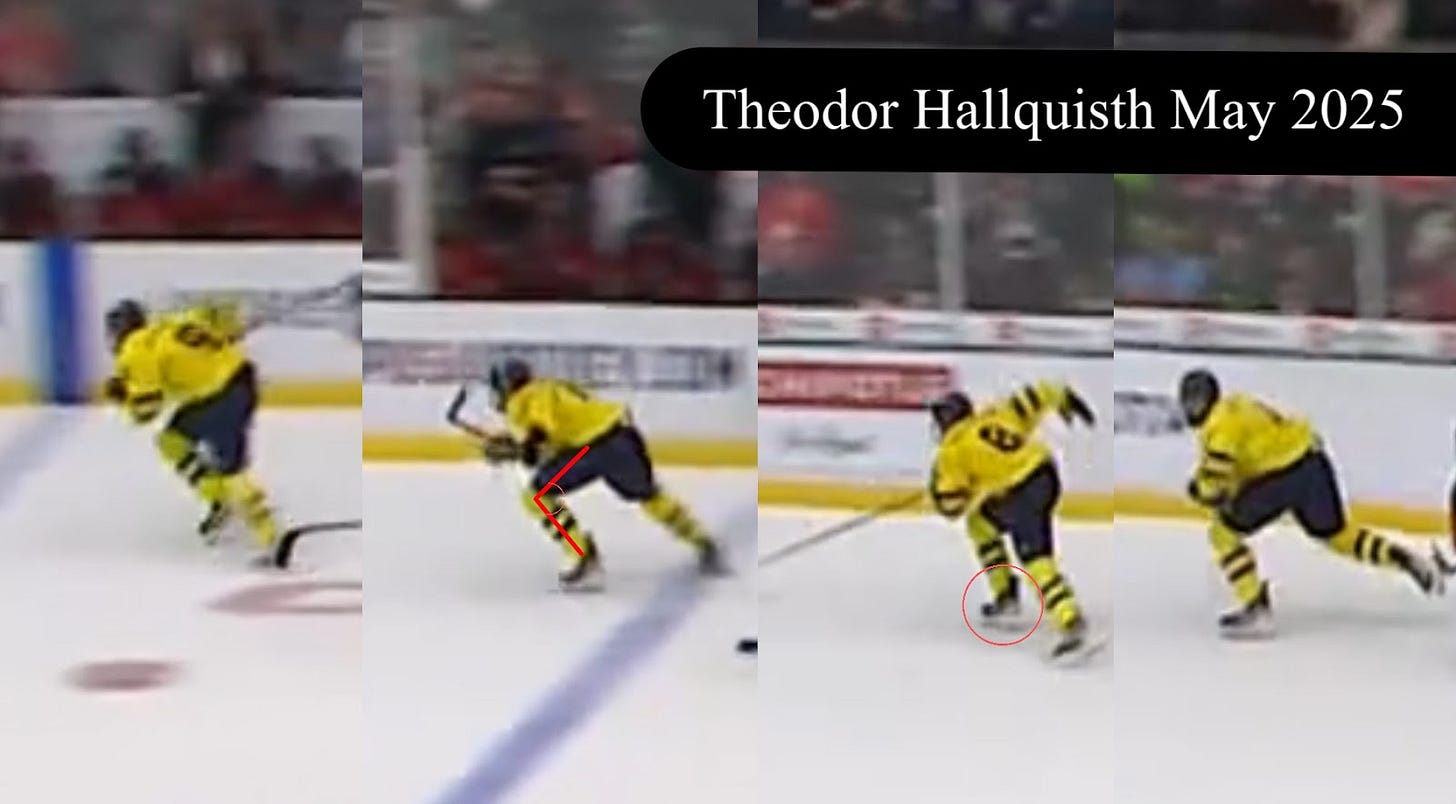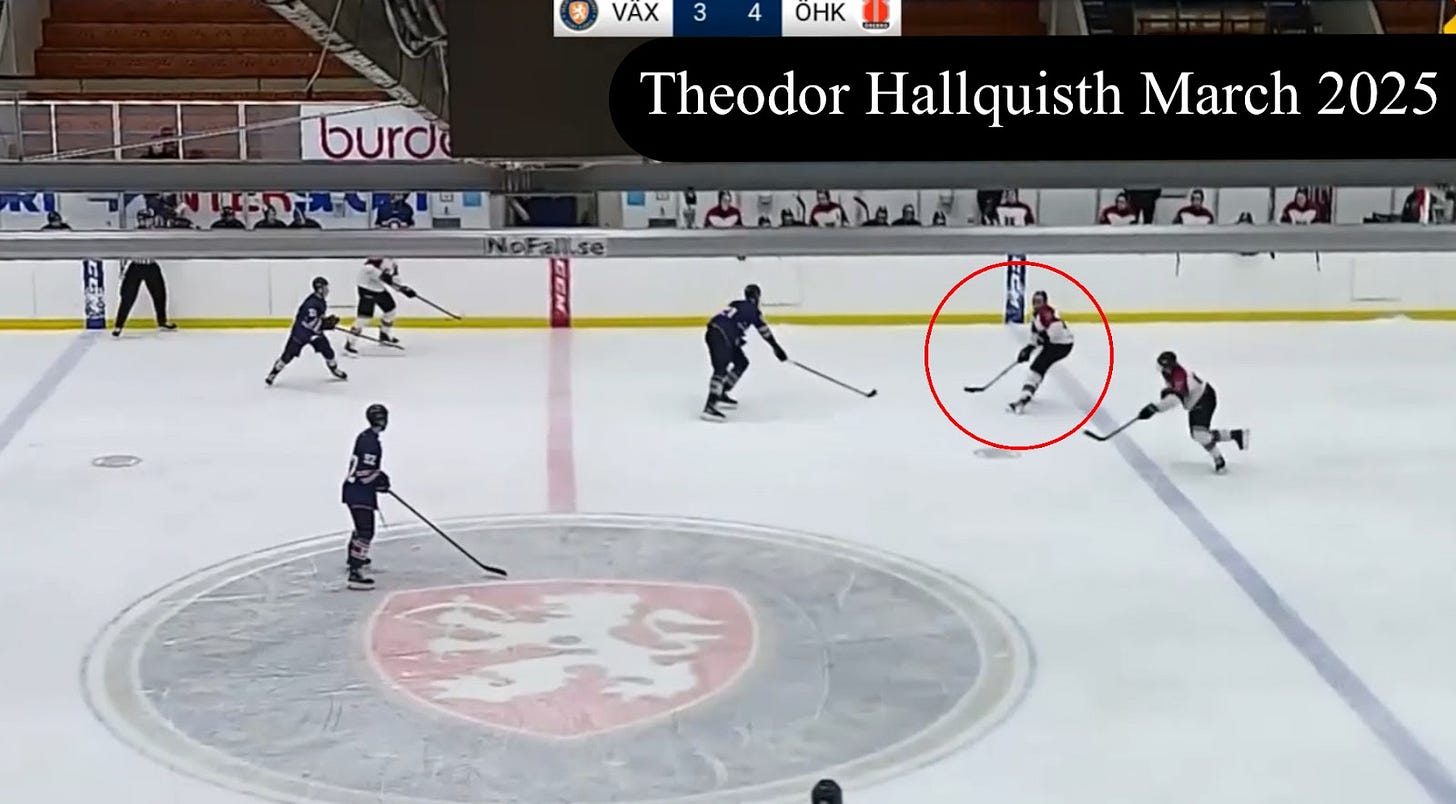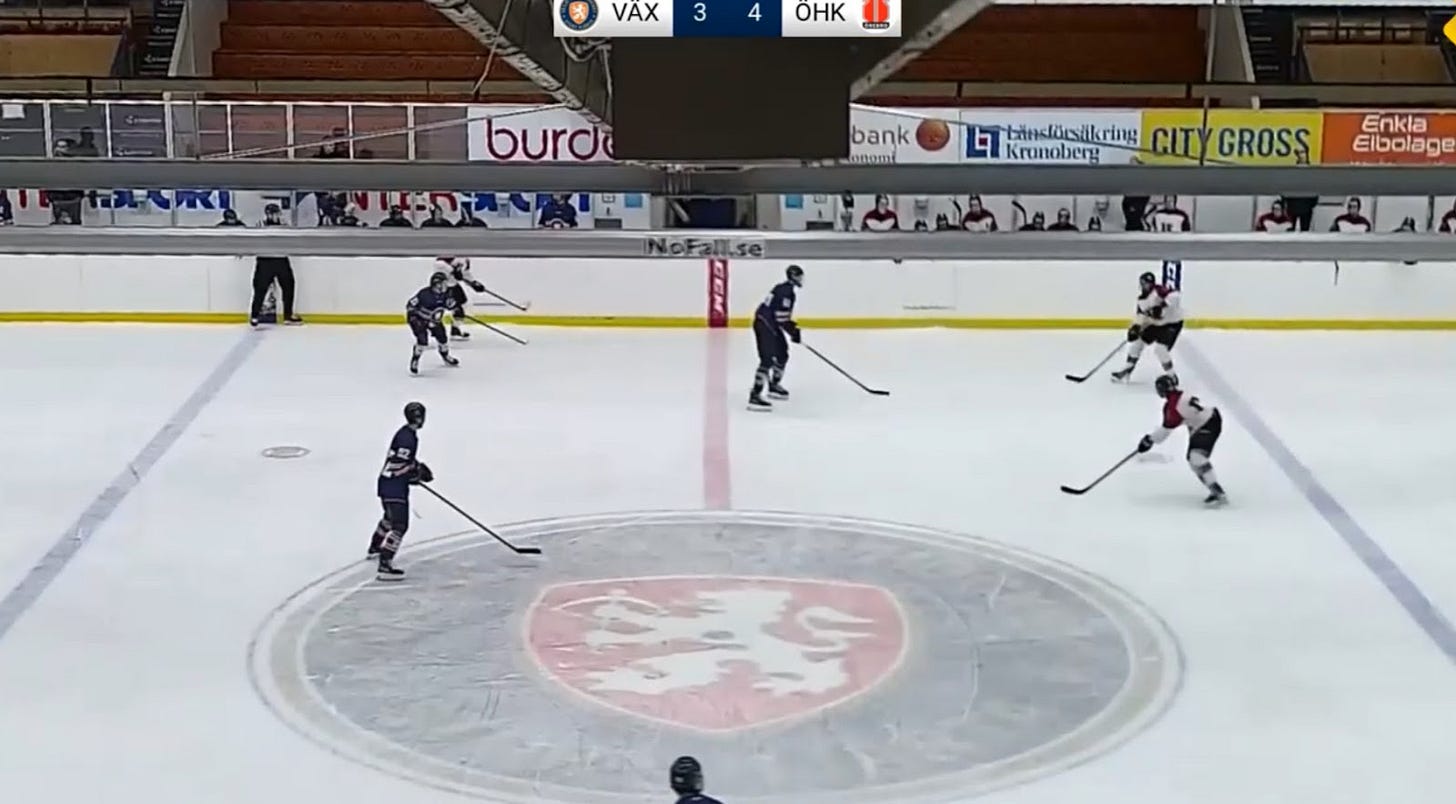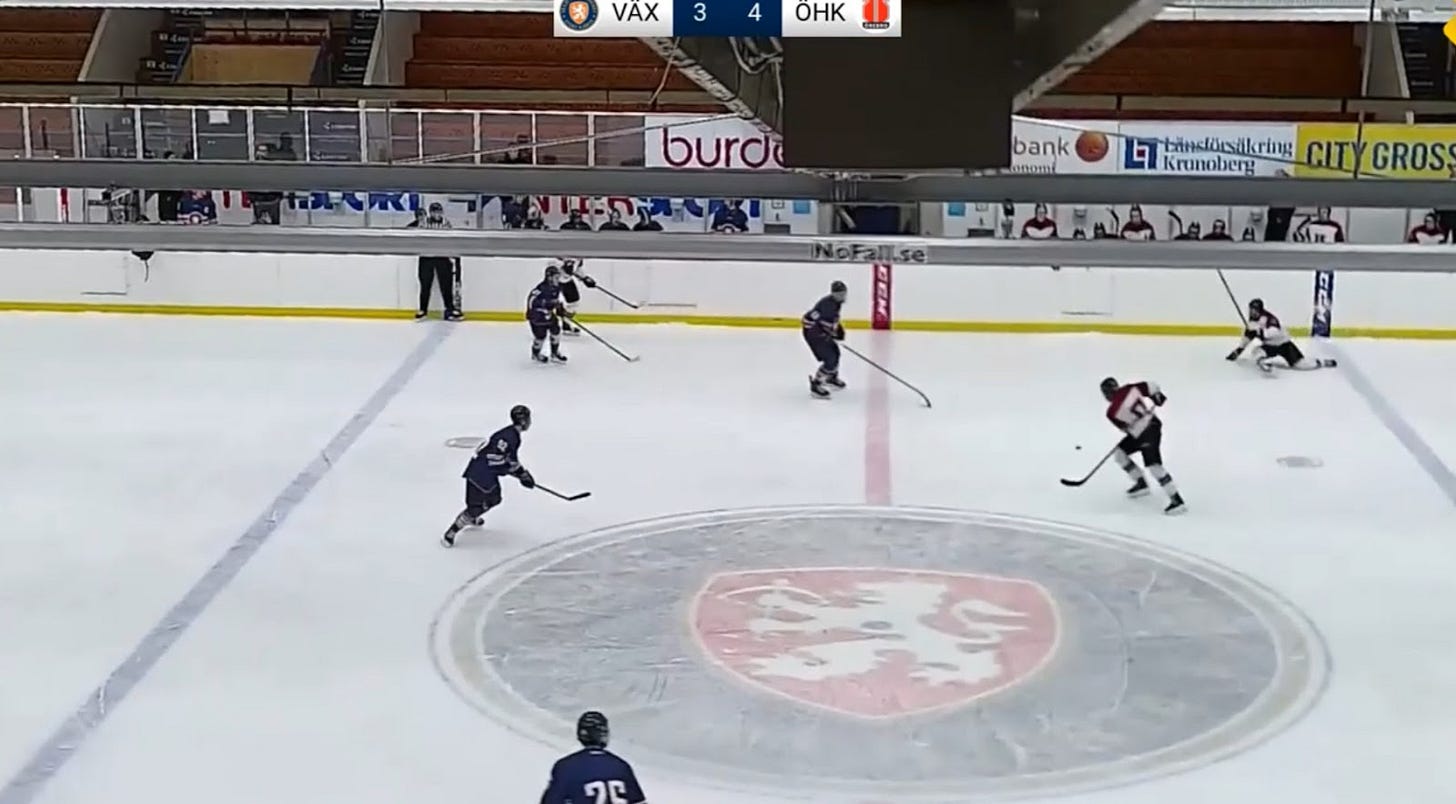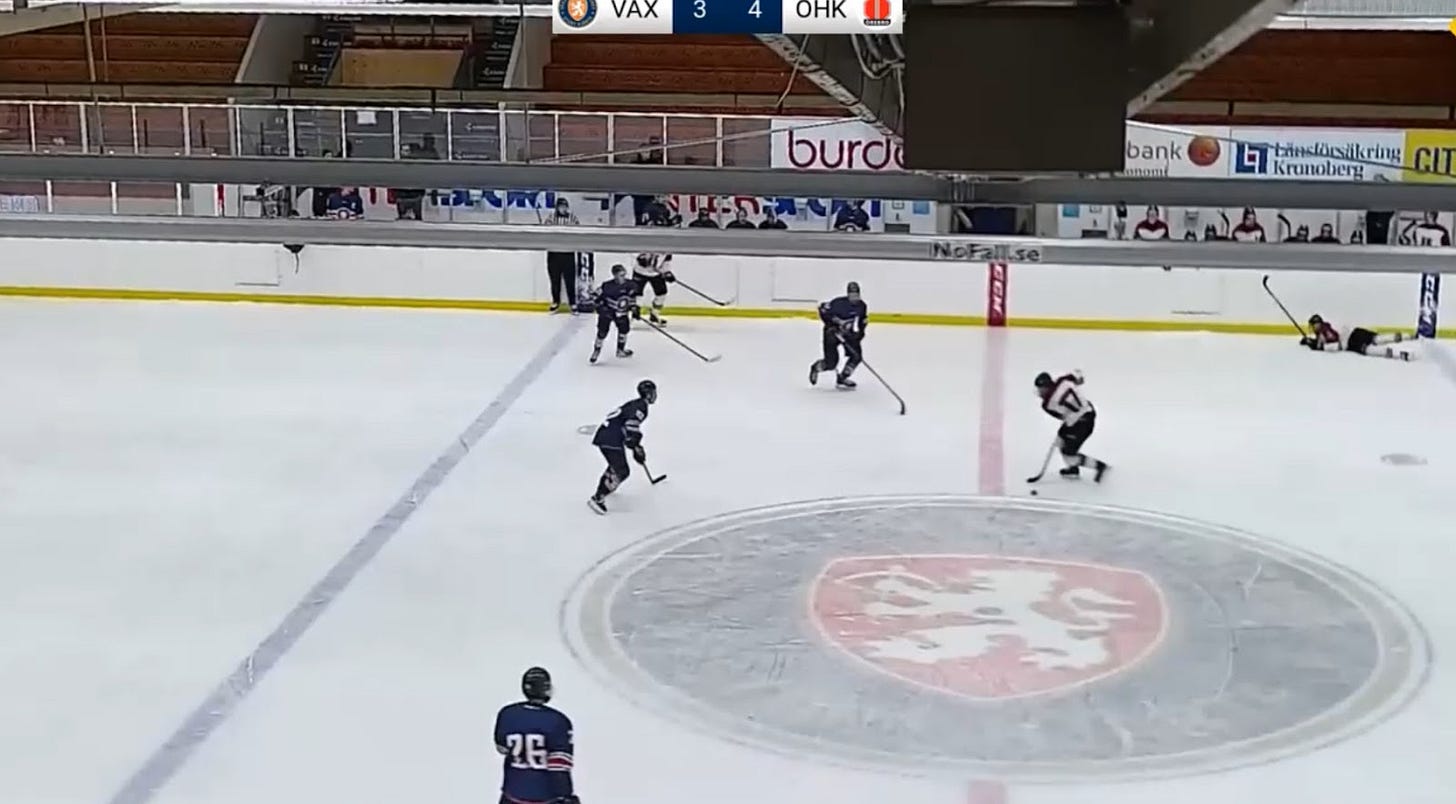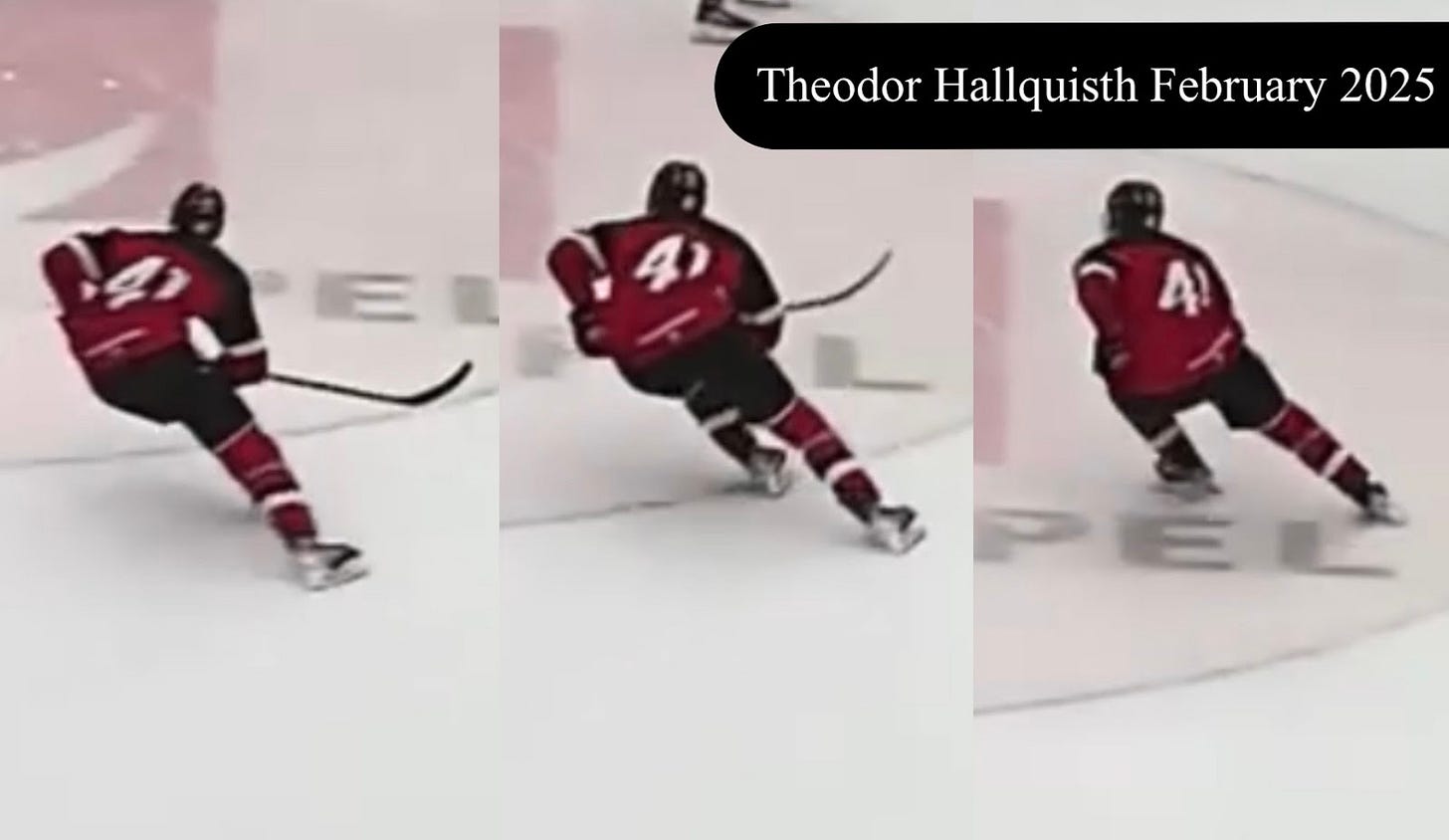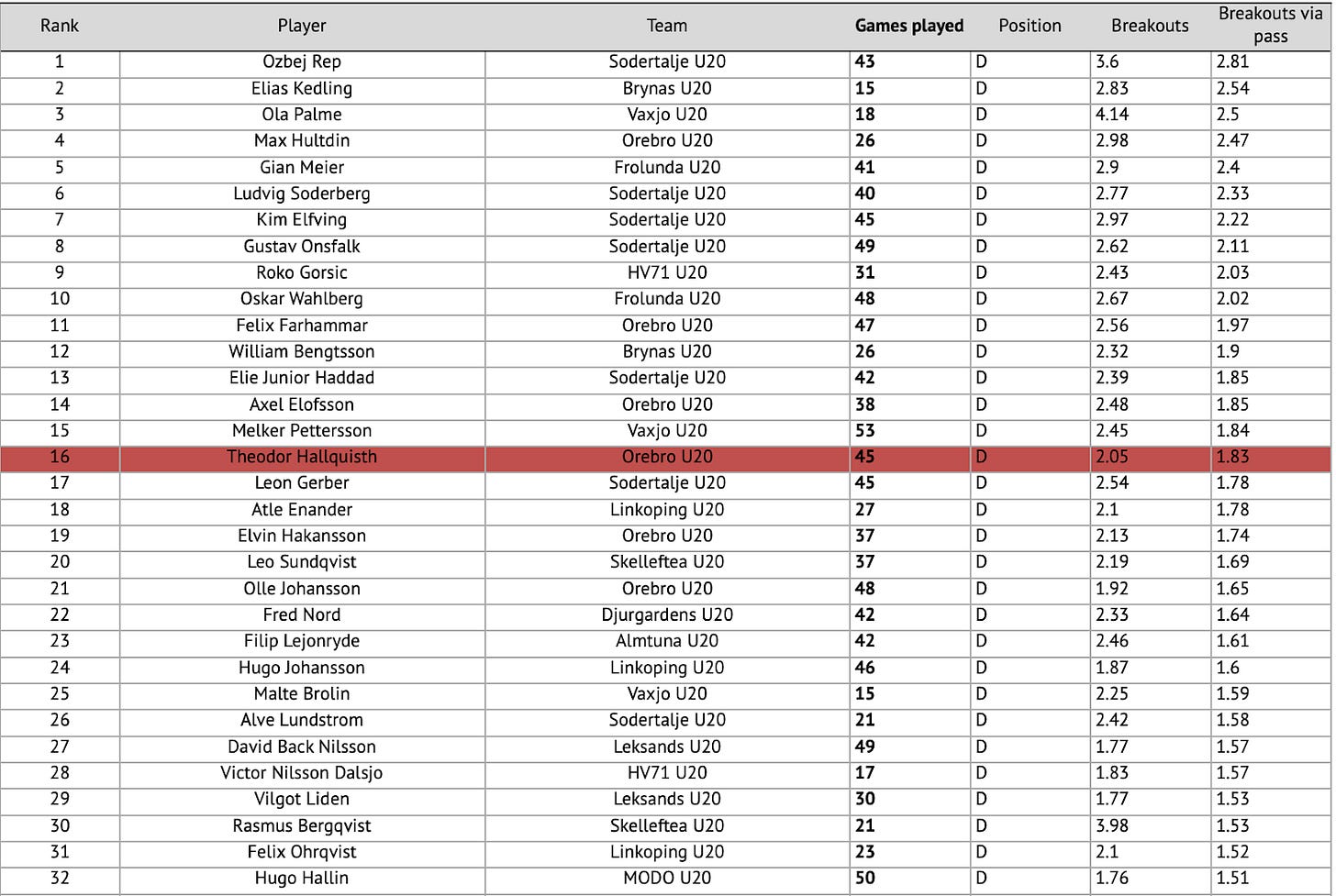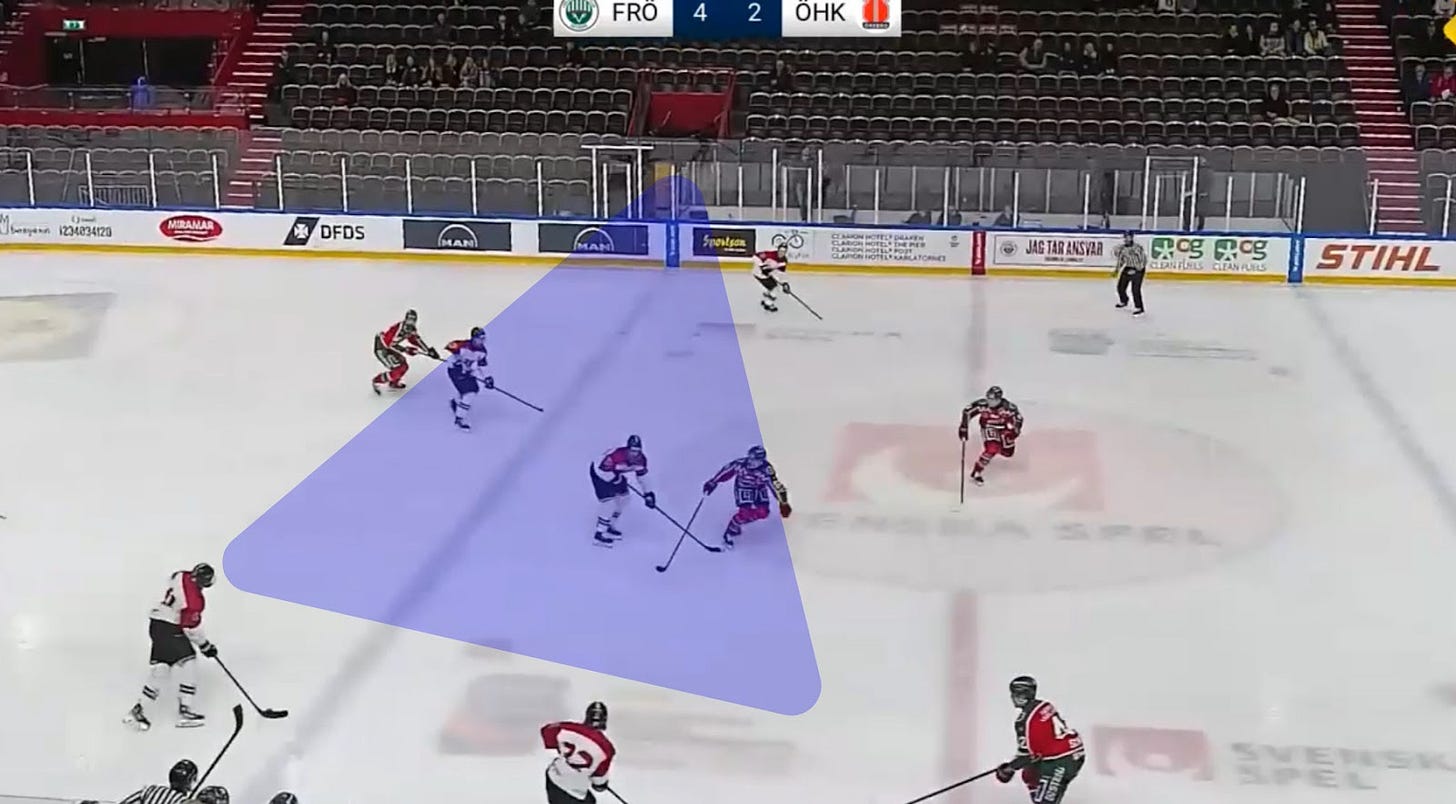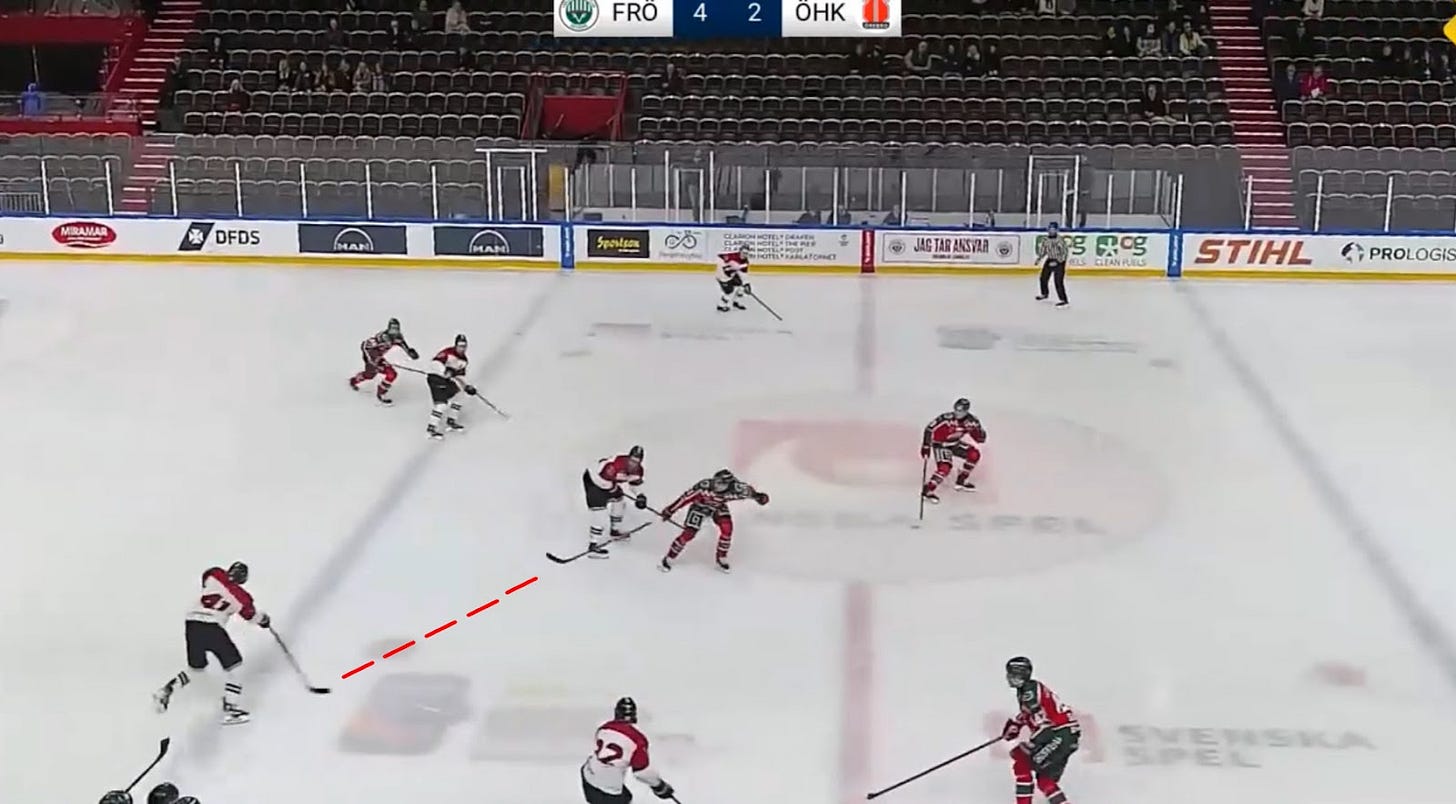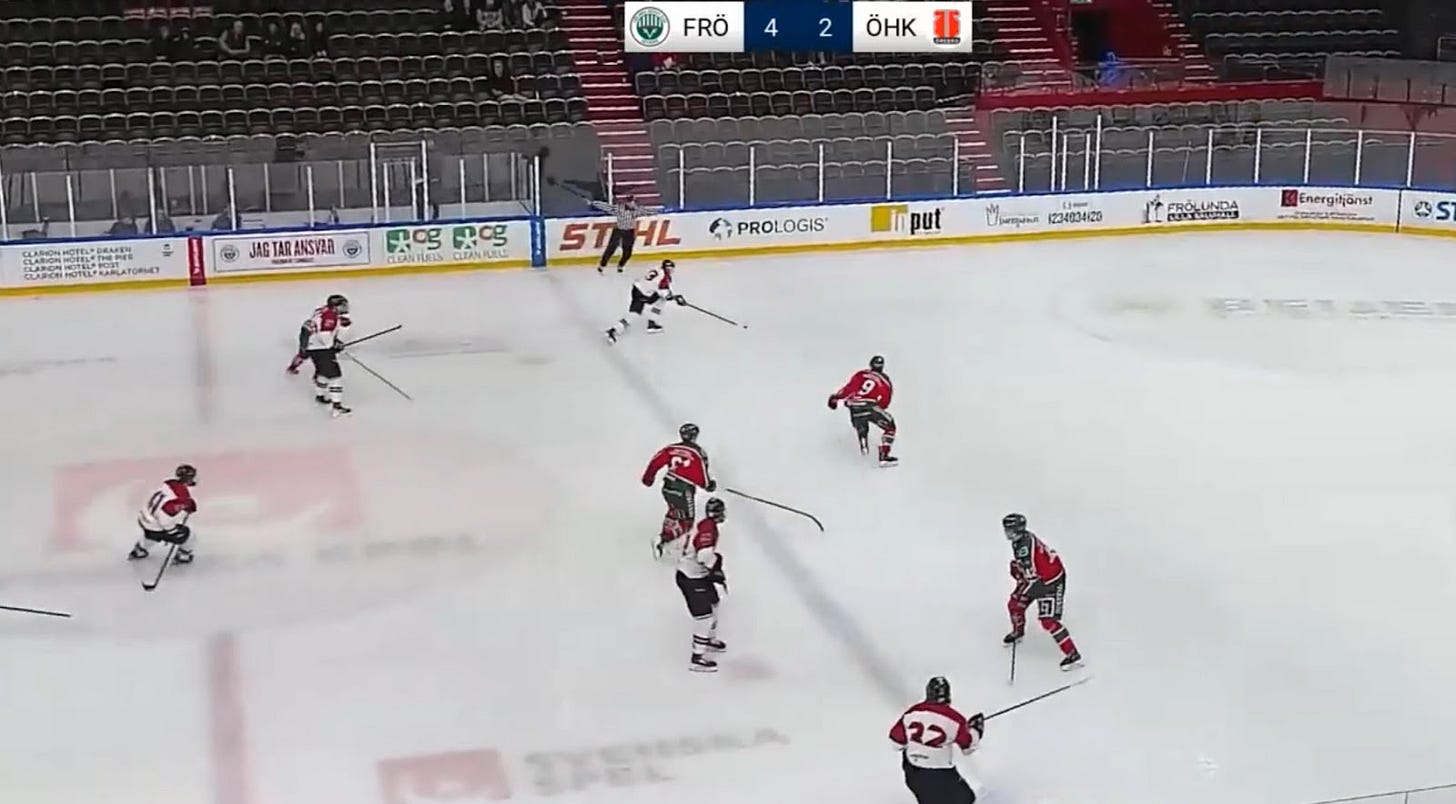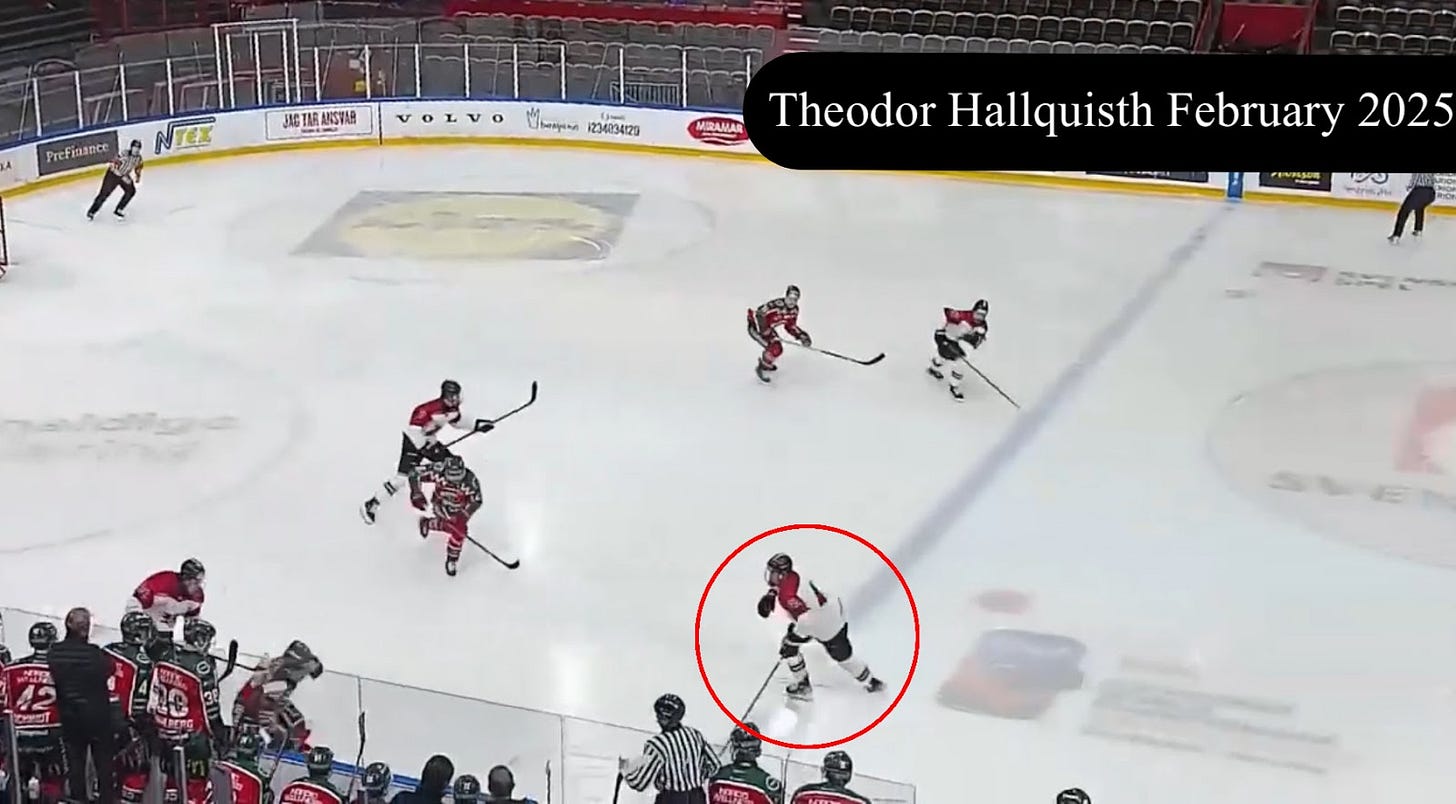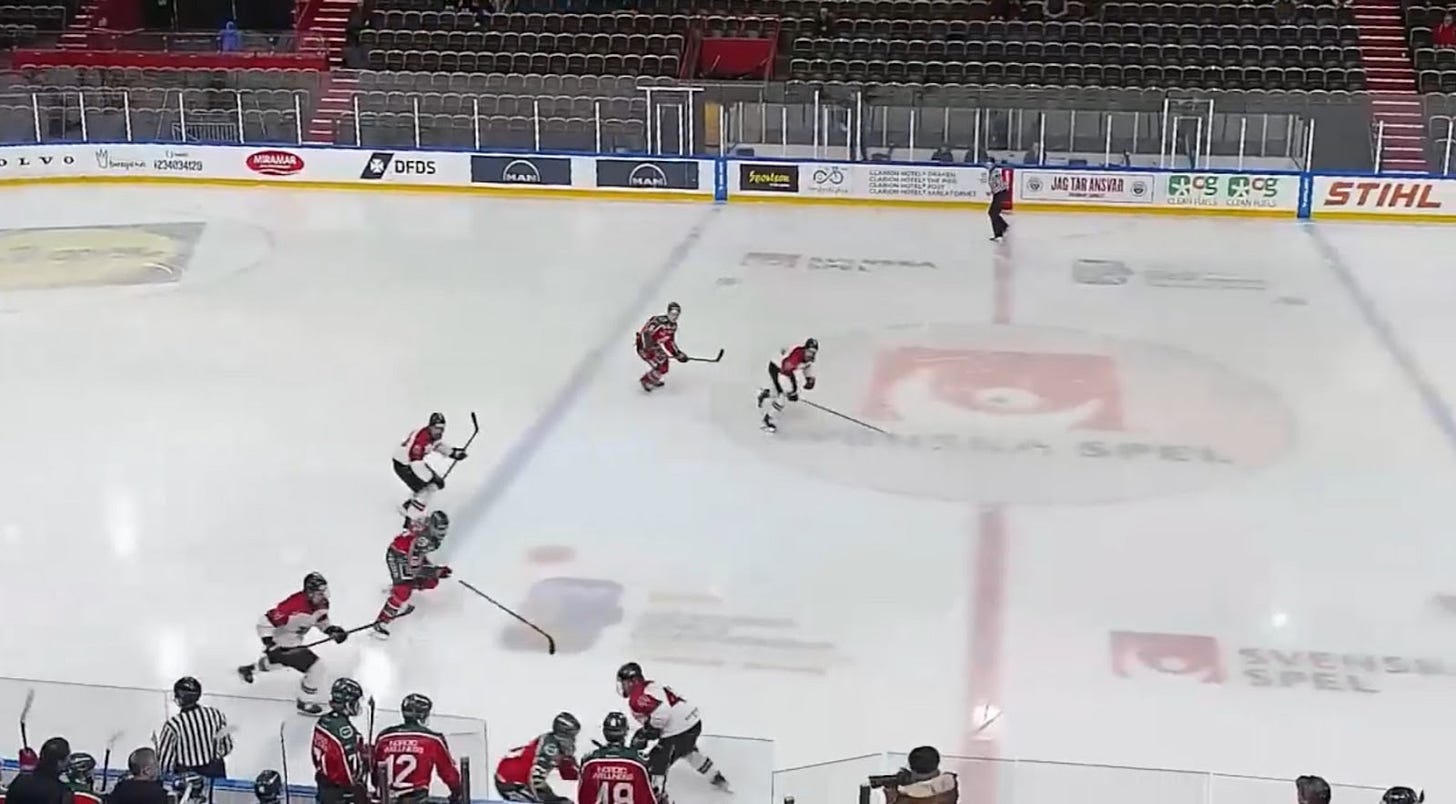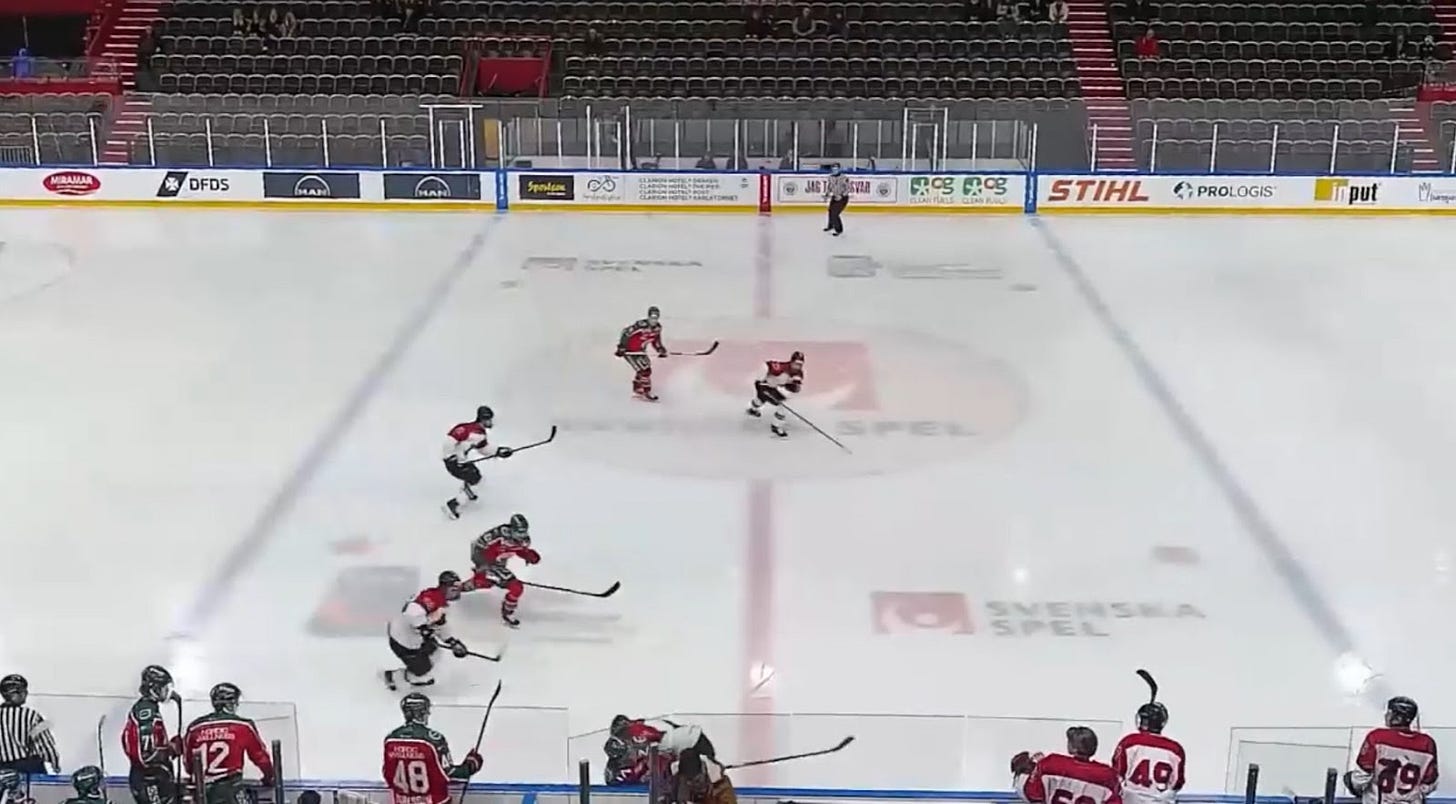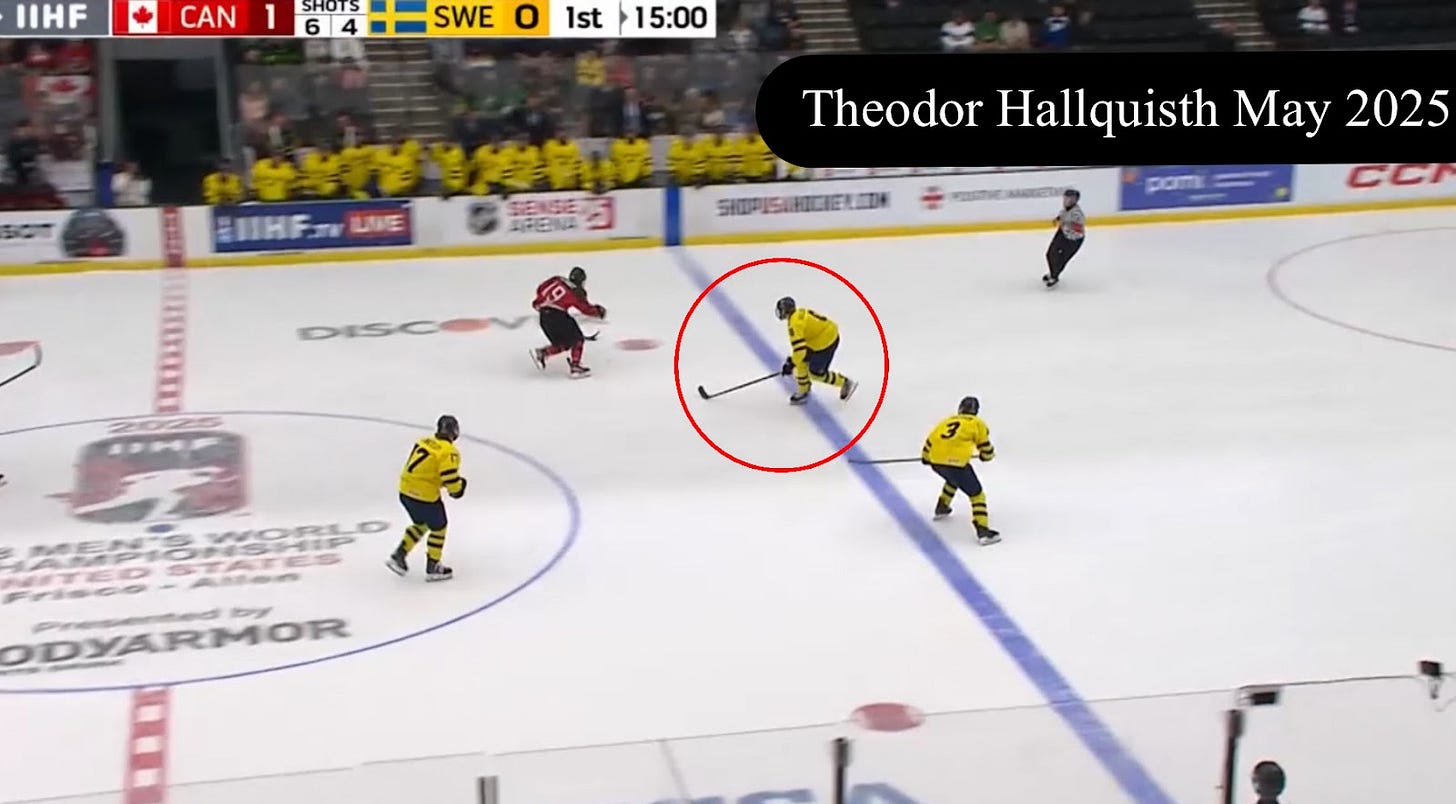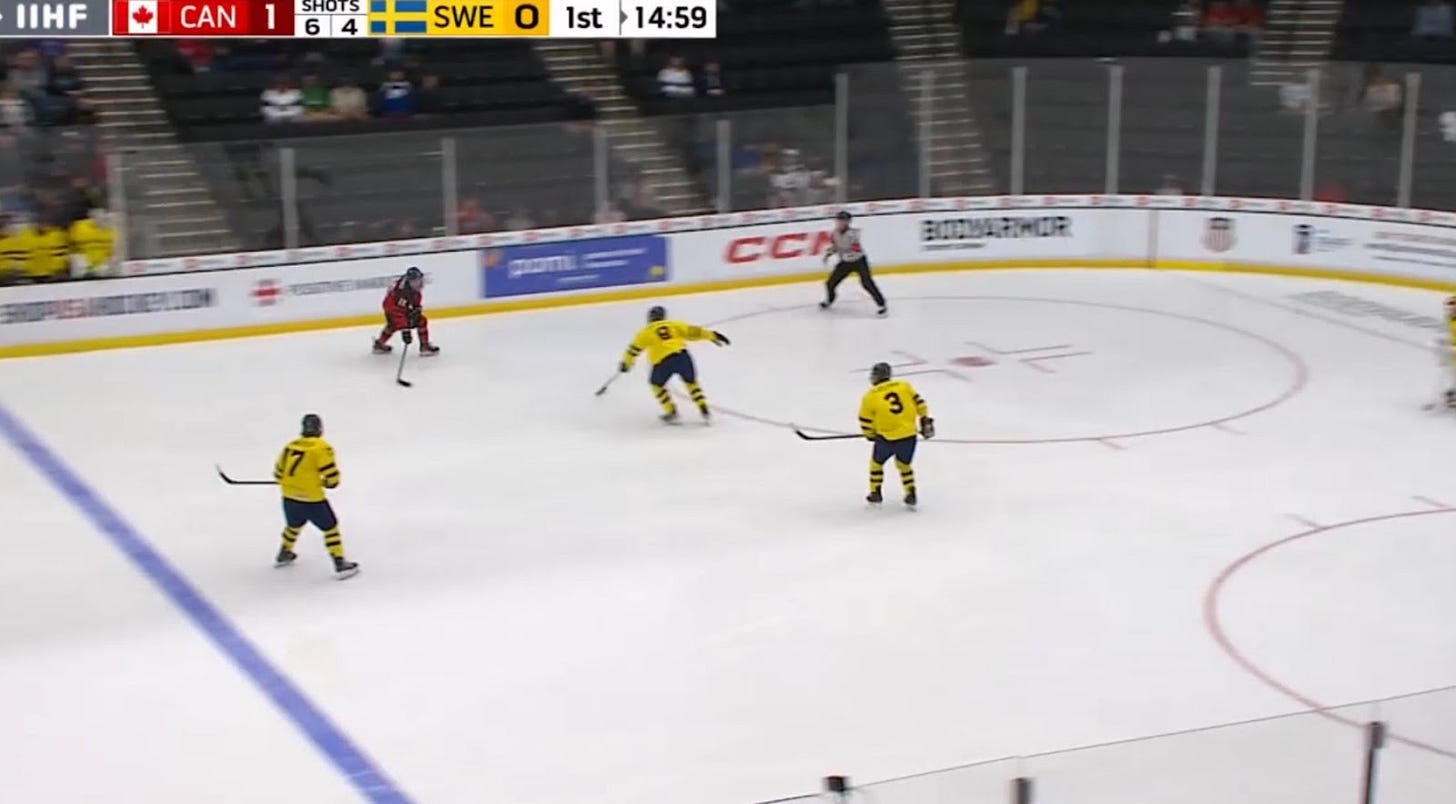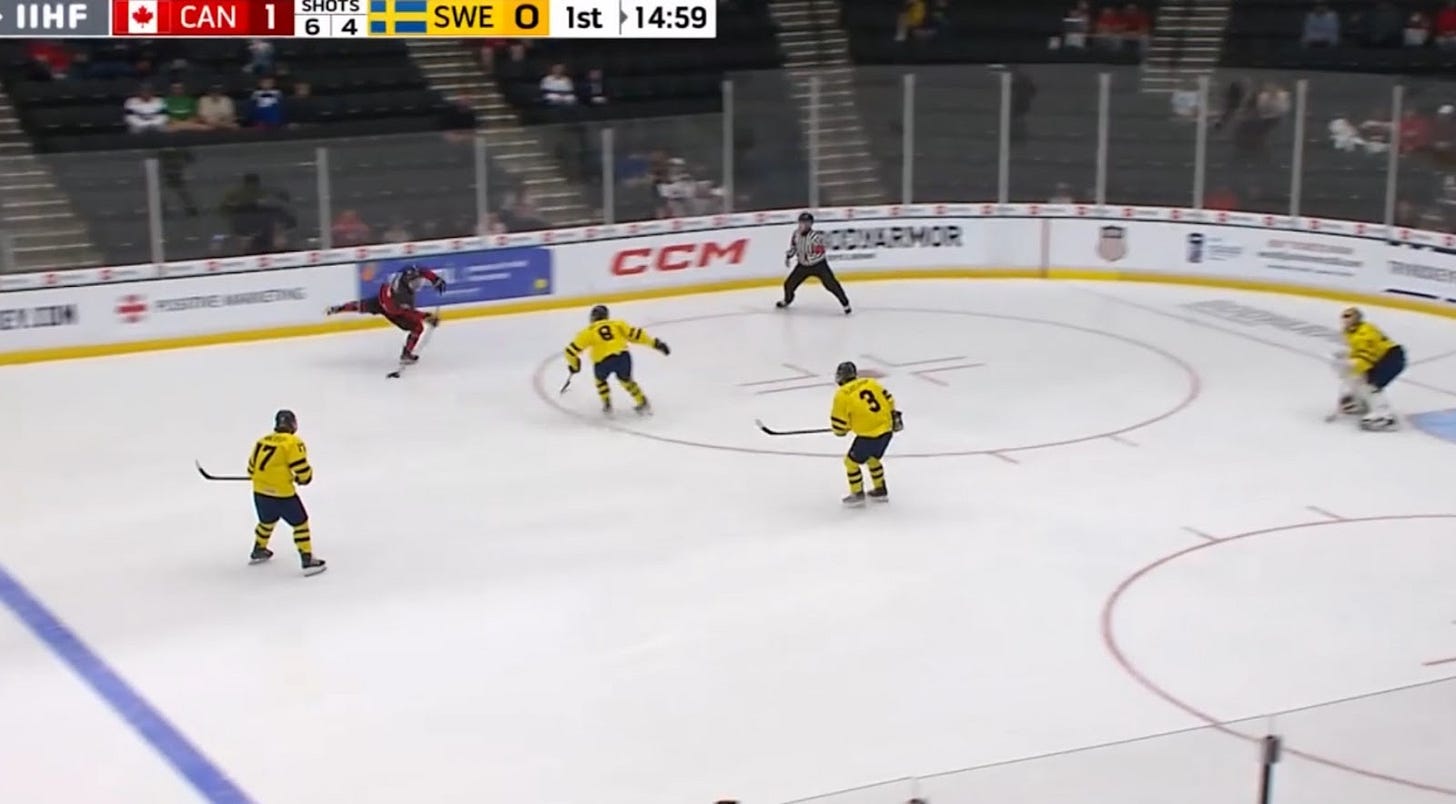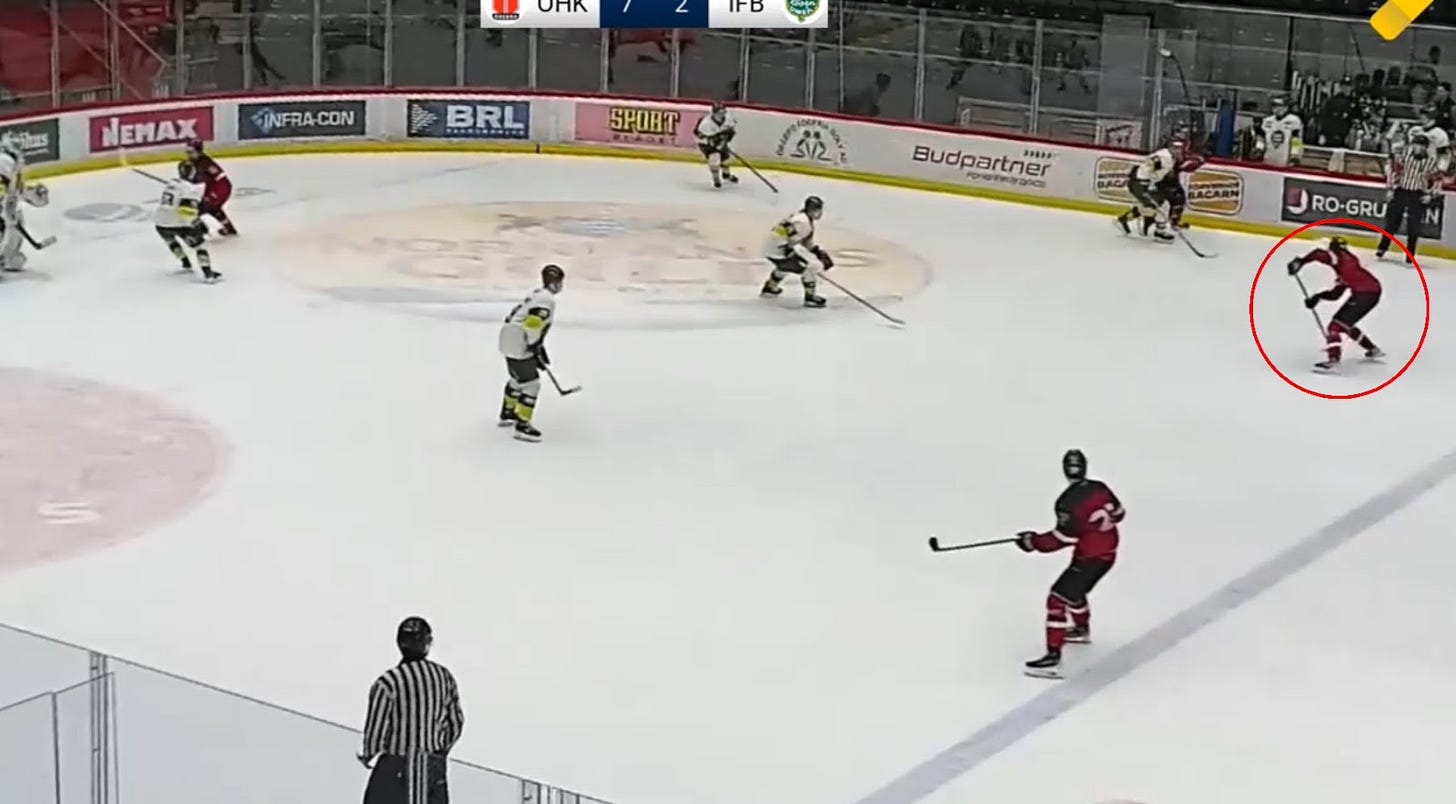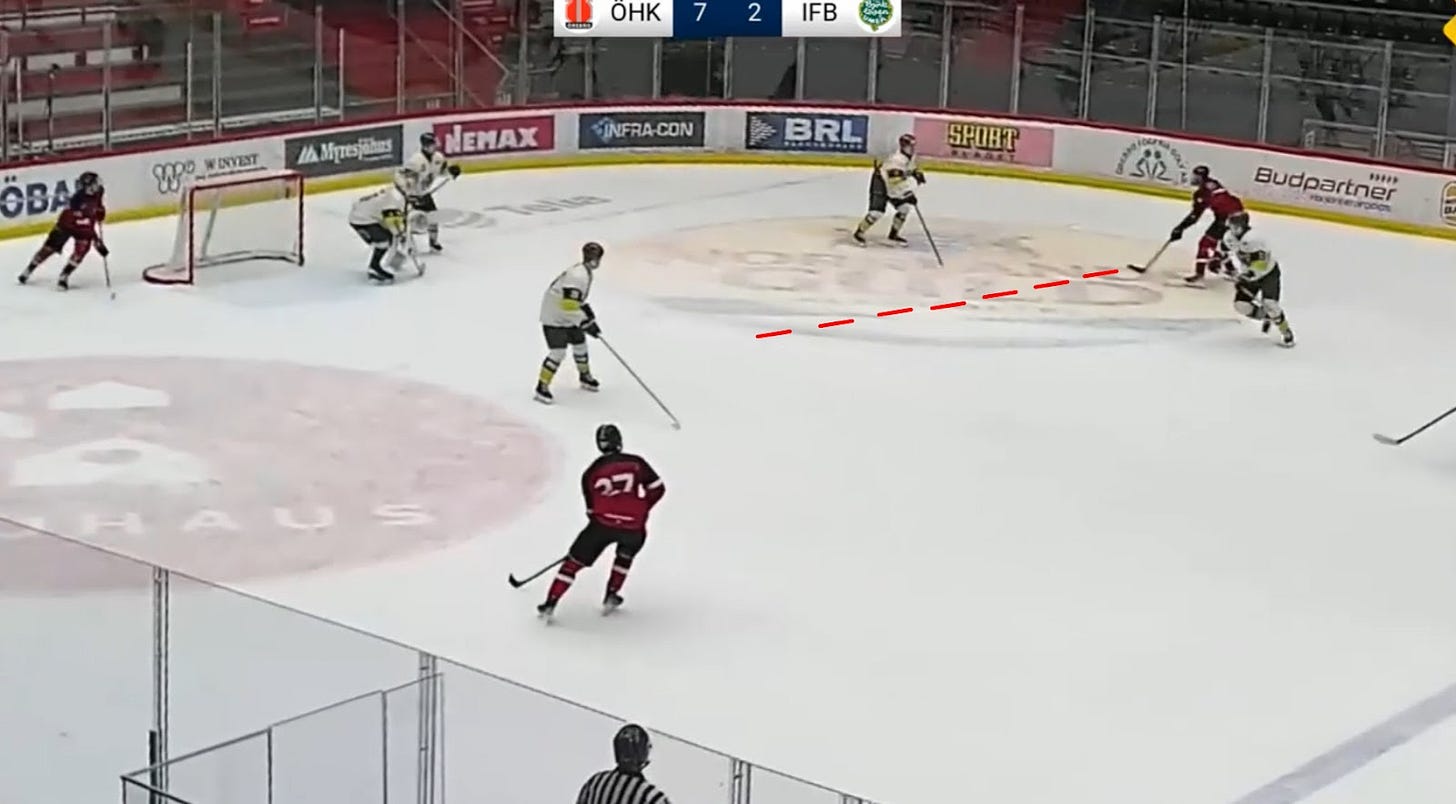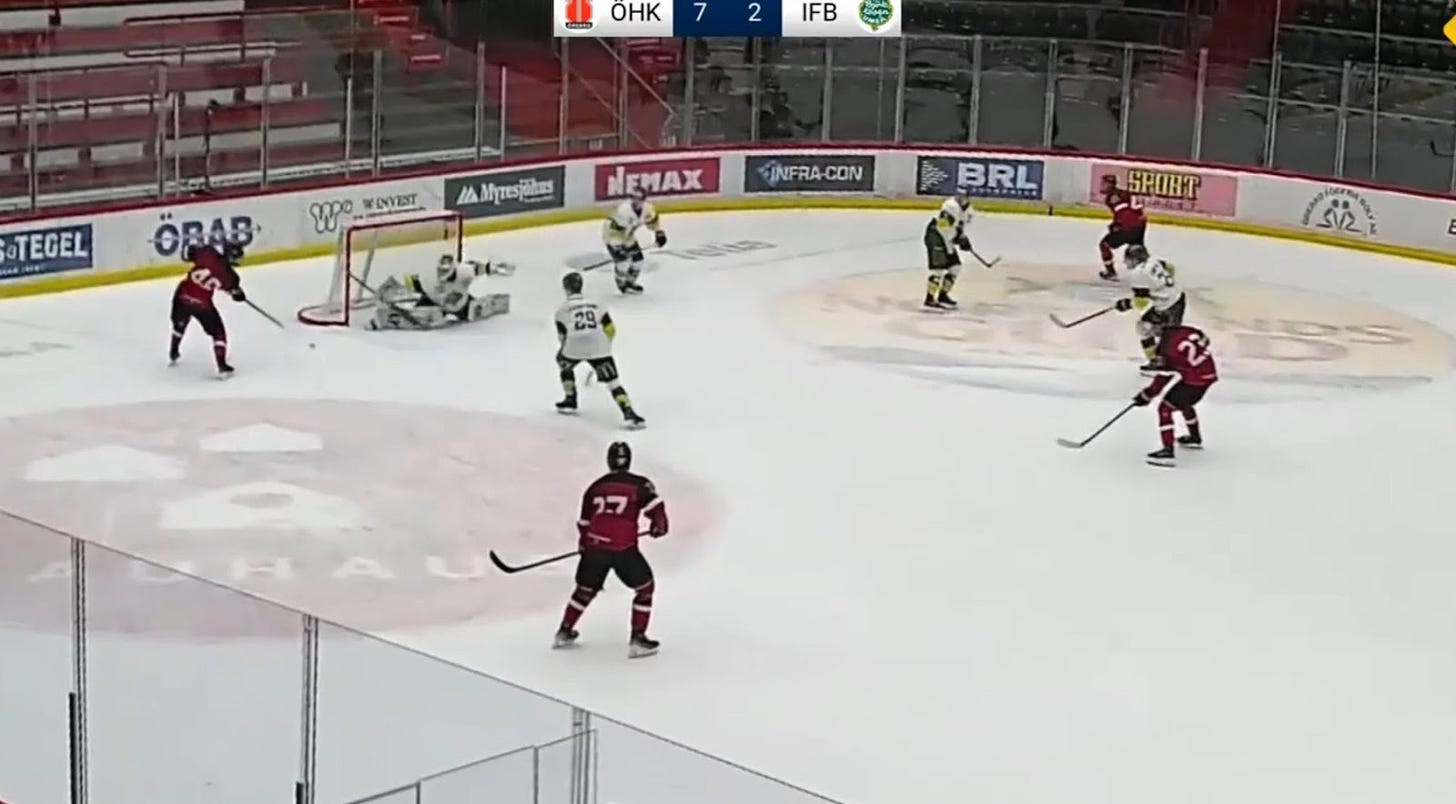Skating:
- Straight Line Skating:
Summarizing Hallquisth’s straight line skating is difficult, but in one word it would be inconsistent. He lacks higher-end quickness and explosiveness but straight line stride mechanics without the puck can be quite refined at times. He gets, at points, very close to full back leg extension, which maximizes his power output. His knee bend is good, close to 90 degrees and enough to keep his knees over his toes and keep his shin and back angle parallel. He does very well in his upper body tilt in his forward stride without the puck and this is something that he has improved on throughout the year, although he still struggles in this aspect during the acceleration phase of his stride. His stride recovery is under the midline of his body allowing for full back leg extension and creating a smooth transfer of momentum to take place. One area of improvement could be his acceleration phase, he kicks his heels up slightly which could be an indicator that he’s not driving through the full range of motion. With that being said, he has a foundation to build on moving forward. There is one big caveat to all of this, with the puck through a myriad of issues which include poor puck placement and dynamic posture, his mechanics both moving in a straight line and laterally are very weak.
Hallquisth had a manually tracked top speed in the 9th percentile of all players I have tracked in my 4 year dataset in the 3 J20 Nationell/U18 Worlds games I tracked of him this season. I should mention that my dataset may be a skewed sample due to my tendency to want to track faster players, but this isn’t ideal.
Lateral Skating:
Hallquisth demonstrates an interesting case in his lateral skating. He has shown some strong four way mobility, but his mechanical issues make it so his mobility works well in a manageable setting but in a fast-paced, chaotic situation, he looks off balance and out of control. He can look stiff handling the puck, and that is not a good sign when you are going to have limited space at higher levels. This is especially evident when he attempts to deke while skating, which also limits his ability to receive passes on the backhand if he expects the pass to be on the forehand and the other way around. His balance remains problematic during lateral movements, a sign of poor dynamic posture. Hallquisth sometimes maintains an upright skating posture with inadequate knee bend, causing instability when executing tight turns or sudden transitions. His high center of gravity compromises his ability to adjust mid-movement, often forcing him into rushed decisions with the puck. These technical shortcomings directly impact his puck-handling capabilities during lateral sequences. It is always going to be hard to handle the puck when one is off balance, like Hallsquith is when moving east-west, frequently mishandling passes or losing possession when pressured.
Hallquisth does show functional mobility in open-ice situations, but his mechanics deteriorate against aggressive forechecking. The lack of explosive power in his crossovers prevents him from creating immediate separation. To address these issues, Hallquisth requires focused development on puck placement, dynamic posture mechanics and even basic skating posture. Improving knee flexion and weight transfer during turns would enhance his balance and power generation. Strengthening his outside-edge pushes and quickening his foot recovery could significantly boost his lateral acceleration. When shifting his weight, he also moves his lower body before his upper body leading to issues in tighter turns. He sets his feet before his hips, increasing his turning radius, slowing the speed of the turn and making his movement more predictable. This leads to needless turnovers, and problems defensively, not being able to maintain proper angles, or create speed inside changes of direction. Without these technical improvements, Hallquisth's skating deficiencies may cap his potential as an effective puck-moving defenseman at the professional level.
Skills:
Transition Offence
Hallquisth isn’t super dynamic but he is smart about how he creates transition offence. His greatest strength lies in his ability to read forechecking pressure and make quick, simpler plays to advance the puck. He ranks in the 96th percentile in entries via pass per 60 among J20 Nationell defenders who have played at least 15 games and in the same group he ranks in the 90th percentile in controlled exits via pass, compared to the 31st percentile in carry exits per 60. (via Instat) This reflects his preference for safer distribution over riskier carries in addition to how his puck placement affects his ability to maintain possession on rushes.
He shows good spatial awareness in transition situations. He has a tendency to use subtle fakes and cutbacks to create separation before making outlet passes, hooking pucks past forecheckers skates and sticks to maintain possession. This deception allows him to complete controlled exits at an impressive rate (78th percentile in controlled exit% among J20 Nationell defenders with minimum 15 games), despite lacking elite puck or skating skills. His passing repertoire is wide and includes simple touch passes, accurate long stretch passes and clever slip passes to draw opponents in and cut through defensive layers. These tools helped him rank in the 96th percentile for zone entries via pass. When joining the rush, Hallquisth demonstrates good timing as a trailer. He has the ability to activate to the weak side and find soft spots in coverage, creating shooting opportunities from the slot. His straight-line speed is adequate for supporting attacks, though his mechanical stiffness becomes apparent when attempting to change directions or handle the puck at top speed.
His 31st percentile ranking in exits via carry reflects his discomfort with prolonged puck possession under pressure. He looks off balance and out of control when handling the puck and struggled to deke while at speed, forcing him into premature passes when forecheckers closed quickly. While he can execute simple give-and-go plays, he lacks the dynamic edgework to consistently beat defenders one-on-one in open ice. Hallquisth's most effective transitional sequences typically involve quick puck movement rather than individual creativity. He's constantly probing with the stick and moving his feet to find passing lanes, showing preference for subtle one-touch passes that maintain offensive momentum. His ability to link up well with his partner on coordinated breakouts suggests he understands how to play within a system, even if he rarely creates something from nothing.
The mechanical concerns remain the biggest obstacle to his transition game translating to higher levels. His tendency to lose balance quite often when trying to manoeuvre on his outside edges cap his upside as a transitional player, though his strong foundational instincts suggest he could develop into an effective second-wave puck-mover with improved technique.
Physicality/Disruption
Hallquisth brings a distinct physical element to his defensive game, combining his solid 6-2 frame with aggressive instincts and a willingness to engage physically that makes it painful to play against. This part of his game stands out as one of his most developed traits, his ability to deliver crushing, momentum-shifting checks is notable. He ranks in the 81st percentile among J20 defensemen (minimum 15 games played) in hits per 60 demonstrates his consistent physical engagement. His physical approach isn't reckless, he shows the ability to time his hits well, though there are instances where his over-aggressiveness can take him out of plays. What he does show well is how he angles opponents into vulnerable positions before finishing his checks. This is an impressive play-killing element and this is most noticeable in the neutral zone. Another one of his favourite areas to lay the body is when he is defending his own blue line.
Beyond pure physicality, Hallquisth shows strong disruptive instincts. His active stick work and anticipation help him break up plays, reflected in his 72nd percentile ranking in takeaways per 60. He's particularly effective against the rush, where his ability to angle opponents away from the middle and disrupt entries stopped chances against. However, there's room for growth in his puck battle efficiency, while he engages frequently (71st percentile in puck battles per 60), his 19th percentile battle win rate suggests he needs to add strength and refine his technique. Hallquisth did manage a -0.47 Rel xGA per 60 compared to his team but considering his role as a top pairing defender, playing against the opponents best players, this isn’t poor by any means.
The physical foundation is promising but requires some refinement. His board play could benefit from more varied stick work to complement his physical approach, and he'll need to continue improving his balance and recovery mechanics after engagements. That said, the combination of his hitting ability and disruptive instincts, give him a physical toolkit that should translate well as he develops. With added strength and experience, Hallquisth has the potential to develop into a genuinely difficult defender to play against.
Rush Defence
Theo Hallquisth is a defenseman who shows both promise and problems when defending against the rush. His best moments come when he uses his long reach and positioning to stop attackers. He has a very active and disruptive stick against the rush, poking pucks away as opponents enter the zone. His stick angle is great when he is in position and this shows great long term potential. This shows itself when the opponent is at a steady pace and directionally predictable, he’s good at steering the, to the outside, guiding towards boards and then engaging physically to create a breakup. However, against faster players, who have gathered speed, his struggles with gap control show. Hallquisth struggles with consistency in this regard. Sometimes he gives too much space and his gap is too wide, letting skilled and fast players burn him. Other times he makes the wrong decision. There have been times he's been caught launching himself at the puck carrier on a 2-on-1, only for the pass to go right by him for a breakaway. His skating can also cause issues, his acceleration issues make it hard for him to recover when he gets beat.
The effort is always there, though. One play stood out where he chased down a 2-on-0 and broke up the play with his stick after a full-speed backcheck. This shows he cares, even when he makes mistakes. Right now, Hallquisth is a mixed bag. He has the tools to be a good rush defender but needs to fix his gap control and consistency to be reliable. If he improves those areas, he could become solid. If not, his mistakes will keep holding him back.
Playmaking
Theo Hallquisth has flashes of elite playmaking vision both in sustained offensive zone sequences and on the counter attack. The young blueliner's passing metrics paint the picture of a high-level puck distributor, ranking in the 91st percentile among J20 SuperElit defensemen (minimum 15 games played) in high-danger passes per 60 minutes.
What makes Hallquisth's playmaking so effective is his combination of precision and hockey IQ. The technical quality of his passes are outstanding, many times he’s been seen slipping passes through heavy traffic and saucing the puck over opponents sticks with good precision. In the offensive zone, Hallquisth shows a knack for advancing play through quick, efficient decisions rather than flashy individual efforts. He has a particular talent for finding teammates between layers of defense. This manifests in his strong shot assist numbers, as he regularly puts pucks into areas where teammates can generate scoring chances. He ranks in the 90th percentile in shot assists per 60 among J20 defenders (Min 15 games played). His preference for controlled entries over dump-ins further demonstrates his commitment to possession-based playmaking.
He is rarely “dynamic” in the offensive zone which can be limiting at higher levels. Instead his ability to deceive defenders before making plays is his dynamic element. This also means that he occasionally misses opportunities to create higher quality offensive chances when space could have been made available. These limitations currently cap his ceiling as more of a reliable distributor than an elite offensive catalyst. However, given his strong foundational passing skills and impressive production metrics, there's clear potential for Hallquisth to develop into a legitimate threat offensively if he can add more variety to his distribution game as he progresses to higher levels of competition.
Perception:
Tactical Recognitions
In the J20 Nationell this season, Theo Hallquisth was deployed as a first-pair defenseman for Örebro HK’s U20 team, which went 15-10-3 and went out in the semi finals. He averaged 21:19 per game, often paired up against the opponents best. This significant workload included 1:56 of power play time (second unit) and 1:36 of penalty kill time (also second unit). While his role wasn’t as extreme as some other top prospects in the league, it still placed him in situations where he was expected to drive transition, contribute offensively, and defend against opposing top lines. Hallquisth also saw a brief, limited stint in the SHL. He appeared in 12 SHL games for Örebro HK, though his ice time was heavily sheltered at just 6:25 per game. This minimal role didn’t provide much opportunity to evaluate his game at the pro level, but it did expose him to the speed and structure of Sweden’s top league, an experience that should aid his long-term development.
Back in J20, Hallquisth was a key piece for Örebro, tasked with moving the puck efficiently and helping stabilize play in all zones. His team’s system, based on a strict defensive structure, likely influenced his defensive performance. Örebro’s structured neutral-zone play helped mitigate his issues with gap control even on bigger ice On special teams, Hallquisth was used in complementary roles rather than as the primary option. His second-unit power play time allowed him to showcase his strong passing ability. However, unlike some other top prospects, he wasn’t leaned on as the main quarterback, which may have slightly limited his offensive production. He didn’t rely on the powerplay for this production with only 33% of his total points coming from the powerplay. Similarly, his penalty kill deployment was more about steady, reliable play than high-event defending. He wasn’t the go-to shutdown option, but he held his own in a secondary role.
Speed Perception
Hallquisth’s game is defined by his ability to process plays before they develop, he has strong scanning habits which at times compensate for flaws in his puck handling. His head is constantly on a swivel, always scanning and collecting information whether retrieving pucks in the defensive zone or surveying options at the offensive blue line, and this awareness allows him to make quick, efficient decisions under pressure. His knack for spotting cross-lane options and executing subtle one-touch passes, stem directly from his pre-scanning. He’s particularly effective in transition, where he uses these reads to bypass forecheckers with short, deceptive feeds rather than relying on dynamic carries.
While he anticipates play development well, his limitations when it comes to skating often leave him a half-step behind when the pace escalates. This shows up in two key ways, neutral zone gaps, where he frequently opts for safer, larger cushions against rushers, knowing he lacks the explosive recovery speed to close if beaten. When he does press aggressively, he occasionally gets caught overcommitting and the second way is puck management under pressure. His scanning helps him identify outlets early, but when forced to adjust mid-play, his stiff handling and labored footwork can betray him. There are moments where he fumbles pucks or makes ill-advised blind passes when hurried, a byproduct of his processing outpacing his physical execution. Hallquisth’s best defensive sequences come when he can control the tempo. He excels at angling attackers toward the boards using his reach, a tactic that minimizes his need for rapid directional changes. Offensively, his deceptive pace manipulation, like hesitation moves or delayed passes, helps create space, but he struggles to sustain advantages in chaotic sequences where quick-strike decisions are required.
Hallquisth’s blend of puck-moving IQ, playmaking potential and defensive awareness makes him an intriguing developmental project. While his skating needs some refinement, it is not bad in other areas. His transition vision and ability to kill plays with smart angling suggest he could carve out a depth role as an NHL defenseman if he improves some facets of his game. Given his flaws, he’s not a sure bet, but as a late-round swing, Hallquisth offers enough translatable tools (defensive stick, playmaking vision, and physicality) to warrant a flier. If his skating progresses, he could develop into a reliable two-way defender with secondary power-play utility. If not, his hockey sense and compete level might still make him a useful AHL/NHL tweener. For teams willing to invest in skating development, he’s a worthwhile gamble in the 5th-6th round range.
Finlay Sherratt
June 2025




